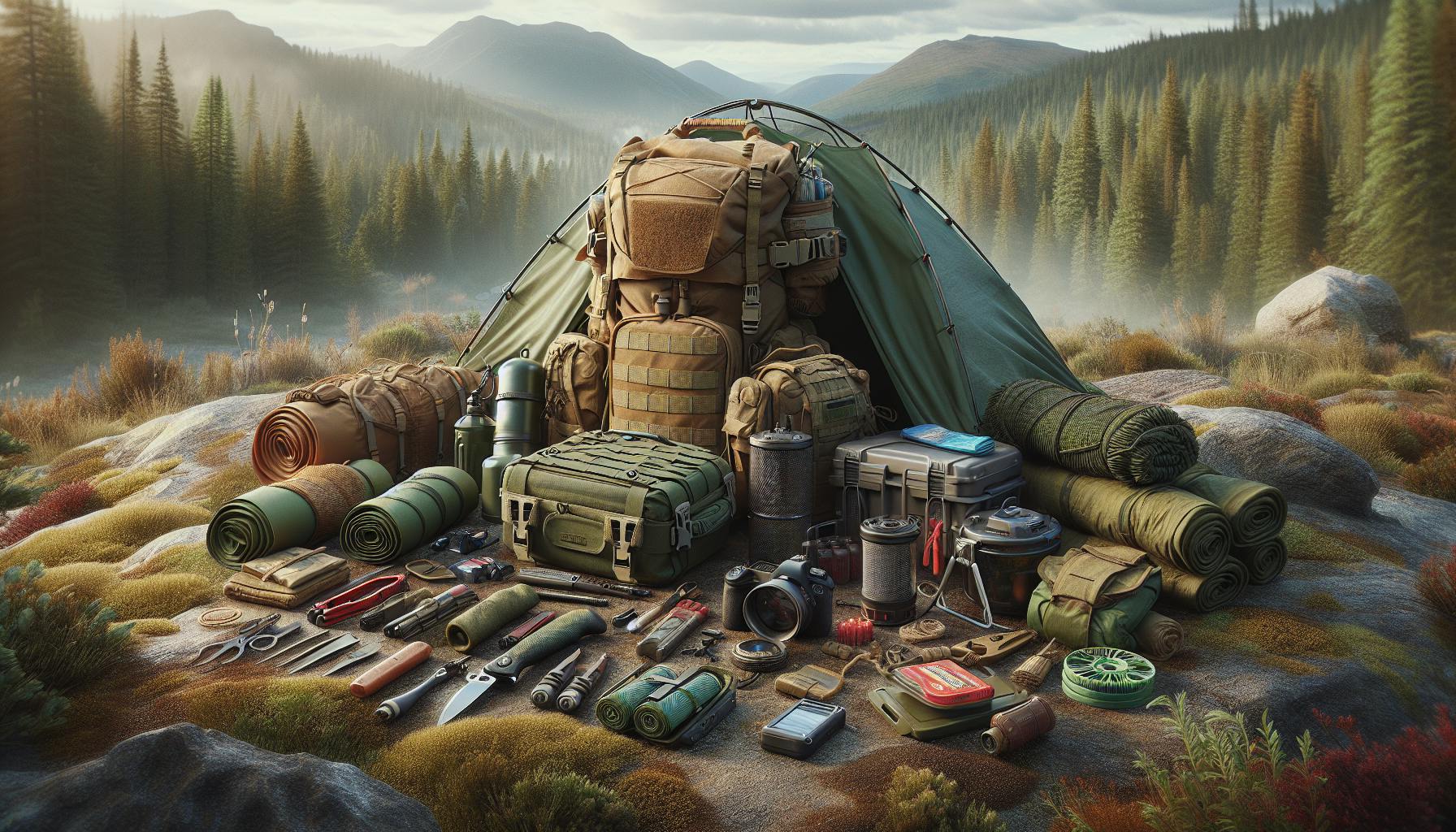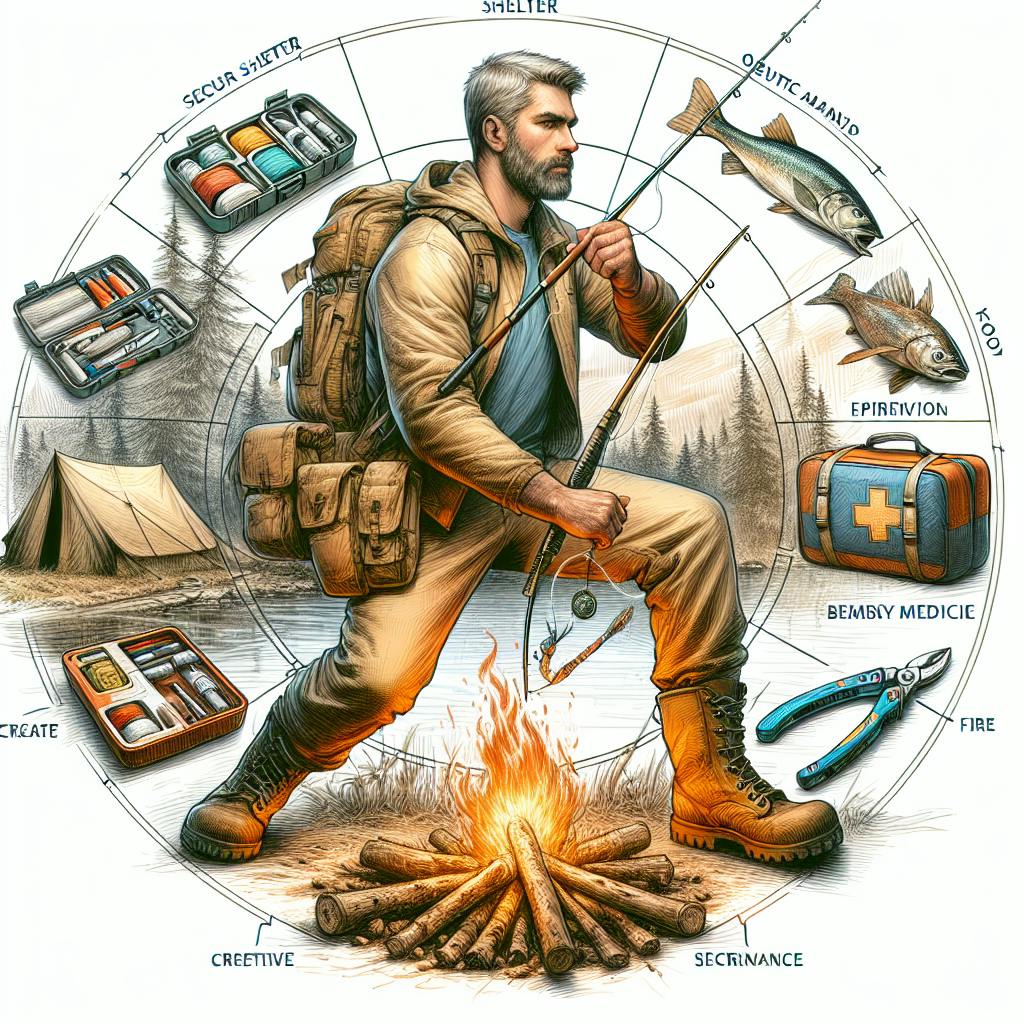When facing harsh weather conditions, most would agree that retaining body heat is critical for survival.
By using a mylar sleeping bag, you can dramatically increase heat retention, even in extreme environments. In this guide, you'll discover how to maximize warmth with a mylar bag for emergency scenarios.
You'll learn the key benefits of mylar for heat reflection, best practices for setup and use, as well as a review of the top-rated mylar sleeping bags for survival preparedness.
Embracing the Mylar Advantage
Mylar sleeping bags provide a lightweight, compact, and weather-resistant emergency sleeping solution. With a reflective surface that retains heat and a durable construction that protects against the elements, mylar bags are a versatile addition to any survival kit.
Understanding Mylar Sleeping Bags
A mylar sleeping bag is a lightweight, low-bulk emergency bag made from reflective mylar material. Unlike regular sleeping bags, a mylar bag relies on your own body heat to keep you warm. The reflective interior bounces heat back towards your body, while the durable outer layer blocks wind and moisture. Mylar bags are tear-resistant, waterproof, and fold up into a tiny package.
The Benefits of Mylar for Survival Scenarios
Compared to traditional sleeping bags, mylar emergency bags offer several advantages:
- Extremely compact and portable
- Reflective material retains body heat
- Waterproof and wind-resistant
- Durable yet lightweight
- Inexpensive and disposable if needed
With their small size and multiple protective properties, mylar sleeping bags are easy to stash in survival kits, bug out bags, and emergency vehicles.
Optimizing Heat Retention with Mylar
To optimize heat retention in a mylar bag:
- Wear dry base layers to wick moisture from skin
- Use a foam sleeping pad for insulation from the ground
- Fold and tape bag edges under body to minimize air flow
- Wrap top of bag around head and cinch opening
- Supplement with chemical hand/foot warmers if needed
Taking steps to maximize insulation and minimize airflow will help the mylar bag better reflect body heat.
The Elements Versus Mylar: A Weather-Resistant Ally
The tear- and water-resistant mylar material provides excellent protection from wind, rain, and snow. The bag's sealed edges prevent moisture from seeping in, while the reflective layer helps block external temperatures. If conditions are extremely cold or wet, try placing the mylar bag inside a waterproof outer bivvy sack for added protection. The durable material can stand up to rough ground and debris without ripping.
Compact and Lightweight: The Traveler's Choice
At just ounces in weight and packing down to the size of a small sandwich bag, mylar emergency bags are perfect for tucking into survival kits, glove boxes, and bug out bags without taking up valuable space or adding bulk. The lightweight, minimalist design makes them ideal for backpackers, outdoor adventurers, and anyone on the go who needs an emergency sleeping solution. When every ounce counts, mylar bags deliver vital protection without weighing you down.
Are Mylar sleeping bags good?
Mylar sleeping bags can be a versatile and valuable addition to an emergency preparedness kit. Here's what customers typically like about them:
Versatility
- Compact and lightweight, making them easy to store in a vehicle, bug out bag, or emergency kit
- Reflective material helps retain body heat in cold conditions
- Waterproof and windproof protection from the elements
Good Value
- Relatively inexpensive compared to traditional sleeping bags
- Provide basic shelter and warmth during emergency situations
- Adequate for short-term outdoor use in a pinch
Winter Vehicle Kits
- Fits easily in a car, truck, or SUV emergency kit
- Insulating layer protects against frigid temps if stranded
- Reflective material traps body heat if you need to stay in vehicle
So while mylar sleeping bags may not replace a well-insulated, long-term use sleeping bag, they offer an affordable and versatile emergency option to stay warm and get through a tough spot if faced with outdoor exposure or temporary shelter needs. If preparedness is the goal, a mylar bag can earn a valuable place in your kit.
What is the best survival sleeping bag?
When choosing the best emergency sleeping bag for survival situations, key factors to consider include warmth, weight, packability, and versatility. Here are some top options to consider in 2023:
Go Time Gear Emergency Sleeping Bag
This sleeping bag is rated as the best overall for emergency preparedness. It is designed to retain 90% of your body heat thanks to the durable, windproof, and waterproof materials. Weighing only 3.2 oz, it packs down small but still fits most body types. The Go Time Gear bag works well for outdoor emergencies as well as home safety kits.
Don't Die in The Woods Emergency Sleeping Bag
If you need a sleeping bag that will keep you extra warm in frigid conditions, this is a top choice. It contains a heating system with a 12-hour heat pack to protect against hypothermia. The bag is tear-resistant and can withstand rugged terrain. Just keep in mind it is bulkier and heavier than other options.
Survival Frog Emergency Sleeping Bag
Survival Frog makes the most lightweight and portable survival sleeping bag on the market today. It compresses down to the size of a soda can, making it easy to stash in a bug out bag or car emergency kit. The bag retains heat effectively and comes with a durable waterproof exterior.
Mezonn Emergency Sleeping Bag
For an affordable emergency sleeping bag without sacrificing quality, Mezonn is a great value choice. This sleeping bag contains multiple layers of insulation to prevent heat loss. It comes with a compact carrying case and is built to be durable enough for repeated use.
Zmoon Emergency Sleeping Bag
If you need versatility, the Zmoon sleeping bag can be fully unzipped and used as a blanket. It is wind and water-resistant, with a reflective interior to radiate heat back to your body. As a lightweight sleeping bag, it works well for hiking and camping too.
Can you reuse emergency sleeping bags?
Emergency sleeping bags made from materials like mylar can generally be reused multiple times if cared for properly. Here are some tips for getting the most use out of your emergency sleeping bag:
- Inspect the sleeping bag after each use for any rips, tears, or damage. Small holes can be patched with duct tape.
- Gently wipe off any dirt or debris with a damp cloth. Avoid harsh cleaners.
- Allow the sleeping bag to fully air dry before folding up to prevent mildew growth.
- Store the sleeping bag in a cool, dry place away from direct sunlight when not in use. Excessive heat can degrade the materials over time.
- Be careful not to tear the bag when getting in and out of it. Try not to wear shoes inside the bag.
- Consider carrying duct tape with your emergency kit to patch any small holes that may occur during use.
Following basic care guidelines will allow quality emergency sleeping bags to be reused many times. But inspect closely before each use and discard if you see major damage or deterioration. Having spare bags in your survival supplies can be wise in case issues do occur down the line.
Are emergency sleeping bags reusable?
Emergency sleeping bags made from Mylar are highly durable and reusable. The Mylar material is designed by NASA to be an excellent insulator, reflecting back up to 90% of body heat to help retain warmth.
Since Mylar emergency sleeping bags are waterproof and windproof, they can withstand repeated use in various weather conditions. As long as the sleeping bag is properly cared for after each use by shaking off any debris and allowing it to fully air dry, it can be folded up and stored for reuse time and time again.
To extend the lifespan of a Mylar emergency sleeping bag even further:
- Be gentle when getting in and out of the bag to avoid rips or tears
- Use a ground sheet or pad underneath to protect against sharp objects
- Store the sleeping bag loosely folded instead of tightly rolled
- Keep it in a dry place away from direct sunlight when not in use
Following these care instructions allows a quality Mylar sleeping bag to be reused for years, making it a worthwhile investment for emergency preparedness. Having a durable and reusable sleeping bag that reflects body heat well can be invaluable for survival situations where warmth is a top priority.
sbb-itb-b932644
Selecting the Best Mylar Sleeping Bag for Emergencies
When selecting a mylar sleeping bag for emergency preparedness, there are a few key factors to consider:
Assessing Temperature Ratings for Optimal Warmth
- Compare temperature ratings to choose a bag that will keep you warm enough for your climate and potential weather conditions during an emergency.
- Bags rated to 0°F or -10°F are good options for most environments. Colder climates may require a -20°F or even -40°F bag.
Choosing the Right Size for Comfort and Coverage
- Consider your body type/size when selecting a mylar bag to ensure proper coverage and comfort.
- Standard "adult" sizes work for most people. If you need more room, choose an oversize or double bag.
Weighing the Options: Finding the Lightest Mylar Bag
- Lighter mylar sleeping bags are easier to transport and store.
- 2-3 lb bags offer a good balance of light weight and durability. Ultralight bags under 2 lbs sacrifice some resilience.
Portability for the Proactive Prepper
- Mylar bags compress down small for storage. Prioritize ones with compression sacks for easy packing.
- Some have convenient carry handles for transport during an evacuation.
Durability Matters: Selecting a Sturdy Mylar Sleeping Bag
- 2-3 mil thickness offers good tear resistance without excess weight.
- Reinforced seams and zippers also improve structural integrity for long-term durability.
By carefully evaluating these key criteria, you can determine the ideal mylar sleeping bag to meet your emergency preparedness needs. The right balance of warmth, comfort, weight, portability and durability will equip you to weather any storm.
Best Practices for Using Your Mylar Sleeping Bag
Properly setting up and using a mylar sleeping bag can help maximize warmth retention and protection from the elements. Here are some best practices:
Strategic Setup for Maximum Warmth Retention
- Set up in a sheltered area out of the wind and off cold ground
- Use a sleeping pad or insulated blanket as a base layer for additional insulation
- Angle bag to reflect heat from a fire or body heat back towards you
Suiting Up: Appropriate Attire for Mylar Bag Use
- Wear insulating base layers to trap body heat
- Use a hat and socks to reduce heat loss from extremities
- Have extra dry clothing available in case of condensation buildup
Sealing in the Warmth: How to Properly Enter a Mylar Bag
- Carefully slide into the bag feet first
- Tuck the edges and ends tightly around your body
- Fold and seal the opening tightly to retain interior warmth
Reflecting on Heat: Positioning Yourself for Optimal Warmth
- Lie on insulating material to minimize ground cold
- Curl up to preserve core body heat
- Adjust bag to reflect heat source onto you
Breathing Easy: Managing Ventilation and Condensation
- Create a small ventilation opening if needed
- Wipe excess interior moisture with a cloth
- Allow the bag to air out periodically
Following these tips will allow you to effectively retain warmth and get the most out of your emergency sleeping bag. With some practice, a mylar sleeping bag can be an invaluable survival tool.
Maintaining Your Mylar Sleeping Bag for Longevity
Pack it Right: Folding Techniques for Mylar Bags
When packing your mylar sleeping bag, follow these steps:
-
Shake out any debris and ensure the bag is completely dry before packing. Moisture can lead to mold growth.
-
Fold the bag lengthwise into thirds, matching up the edges and corners. This helps compact the size.
-
Roll the folded bag tightly from bottom to top. Squeeze out excess air as you roll. Secure with a strap or elastic band.
-
Store the rolled bag in a waterproof stuff sack or plastic bag. This protects against dirt, water, and punctures during transport.
-
Avoid crushing or sharply bending the bag when packed. The mylar material can crease, tear, or crack.
Protecting Your Investment: Avoiding Common Damages
To prevent rips, tears, and holes when using your emergency mylar sleeping bag:
-
Inspect the ground underneath before laying it down. Remove sharp rocks, sticks, and other debris.
-
Be gentle when getting in and out of the bag. Avoid snags from belt buckles, jewelry, boots, etc.
-
Store properly between uses. Keep away from pets, lawn mowers, etc. that could damage it.
-
Consider using a ground tarp first for extra abrasion protection.
Handling the mylar bag gently and minimizing contact with sharp objects is key to avoiding inadvertent damage.
Clean and Ready: Mylar Bag Care Guidelines
For periodic cleaning and maintenance:
-
Use a soft brush and mild soap and water to remove surface dirt if needed. Avoid harsh cleaners.
-
Check seams and edges for any small holes or tears. Seal with heat-safe mylar repair tape.
-
Let the bag completely air dry before packing away to prevent mold or mildew.
Storing the bag loosely in a breathable container helps it stay fresh and ready for your next adventure. Following these care tips will extend the life of your emergency mylar sleeping bag for many years.
Expert Picks: Best Emergency Sleeping Bag Review
When choosing an emergency sleeping bag, a mylar sleeping bag is an excellent option to consider. Mylar bags are lightweight, compact, and designed to retain body heat very effectively. This makes them ideal for emergency and survival situations when you need reliable protection from the elements.
In this section, we will review some of the top contenders for best mylar sleeping bag and compare their key features and real-world performance based on user experiences. We will also evaluate their cost-effectiveness to help you choose the right option for your needs and budget.
Top Contenders: Comparing the Best Mylar Bags
Some of the most popular mylar sleeping bags on the market right now include:
-
Survive Outdoors Longer Emergency Bivvy: This mylar sleeping bag is designed for superior heat retention with its double-layered mylar material. It packs down small but offers ample room inside.
-
Sol Emergency Bivvy: This emergency bivvy is ultra lightweight at 3 ounces. It's waterproof and windproof with an aluminized interior to reflect body heat.
-
Grizzly Gear Emergency Sleeping Bag: This bag combines a mylar layer with soft fabric lining for increased durability. It has a drawstring hood and zippered bottom for adjustable ventilation.
Key factors to compare are weight, packed size, dimensions, heat retention ability, water resistance, and special features like hoods or zippers. The Survive Outdoors Longer bag excels in warmth while the Sol Emergency bivvy is the lightest. The Grizzly Gear option offers more versatility.
Real-World Performance: User Reviews and Feedback
According to most user reviews of mylar sleeping bags, they perform very well for temporary emergency shelter and warmth. Users say these bags trap body heat quickly on cold nights. They've proven effective in extreme conditions from snow storms to deserts.
Some downsides mentioned are condensation build-up inside and the "crinkly" noise of the material. A few users warn that mylar can rip when snagged so these bags need gentle handling. Overall though, user feedback confirms their excellent real-world performance as survival sleeping bags when needed.
Value for Money: Cost Versus Benefits
Mylar sleeping bags provide exceptional value for their low cost of $10 to $20 on average. Their compact pack size and ultralight weight make them easy to stash in emergency kits and bug out bags without taking up much room.
Considering their proven life-saving performance in harsh conditions, mylar bags are an invaluable addition to your survival gear. Most users agree the benefits far outweigh the costs when it comes to potentially life-threatening emergencies. For the small investment, a mylar bag gives good insurance and peace of mind.
Survivalist Endorsements: Which Bags Make the Cut?
Many survival experts recommend mylar sleeping bags as an essential item for emergency preparedness kits. Well-known survivalist Dave Canterbury is a big advocate of mylar bags as a versatile tool integrated into most of his camping gear.
The Sol Emergency Bivvy comes highly rated by survival instructors for its light weight and heat reflective properties. Other favorites are the Grizzly Gear and Survive Outdoors Longer bags for their added features like stuff sacks for organization.
Most authorities endorse some form of mylar sleeping bag or bivvy sack as standard equipment for dealing with emergencies in the wilderness or urban settings. Their durability, warmth, and portability make them a survivalist go-to for emergency shelter.
Conclusion: Wrapping Up the Mylar Sleeping Bag Guide
A mylar sleeping bag can be an invaluable tool for emergency preparedness. The reflective and insulating properties help retain body heat, while the waterproof and tear-resistant material protects against the elements.
When using a mylar sleeping bag, be sure to wear breathable layers underneath to prevent moisture buildup. It also helps to place an insulating pad or blanket underneath for additional warmth and padding. Consider storing handy items like a flashlight, pocket knife, lighter, or snacks in the bag's interior pockets for easy access.
Having a quality mylar sleeping bag in your survival kit provides reliable, lightweight protection to get through unexpected outdoor scenarios. Pair it with other key gear like shelters, water, fire starters, and first aid for comprehensive disaster preparedness. With the right knowledge and resources, you can stay warm and safe from the elements.


